The hydrostatic watershed up to 1968
|
Comparation 1968-2009
|
Streams twirl in 2009
|
I want anyway to write to help also non-native Venetians to clearly comprehend what is happening to the City and yes, to have the barbarians face the global effect of their year-by-year wrongdoings...
How 50 years of insane hydraulic interventions in the Lagoon of Venice have ruined its multi-secular artificial balance
|
Natural Lagoons are dynamic organisms, subject to seasonal shape changes, to open in gulfs or to become land in the short time of decades.
The Venetians resolved to intervene on these natural dynamics generated by the double action of the Sea and the Rivers, in the aim of steadying the Lagoon of their cities in a shape the most convenient to the preservation, the development and the defence of Venice in the shelter of its calm, healthy and teeming with fish waters.
Proper Magistrates drove the fresh and the salty waters in the double scope of mantaining them quiet and healthy. As is allow a daily replacement with the Sea but avoiding the formation of fast streams.
The marvellous result obtained by Venetian Hydro-engeneering was "fissare le velme", (the fixing of the muds), as is to balance the quantity of sediment phased in the Lagoon by the rivers and by the Mainland erosion, with the quantity removed into the open Sea by the flow tide.
About 400 years were taken (between 1100 and 1600) to steady the Mid Lagoon were Venice lays, and 200 years more to reclaim the South and North Lagoon while freeing the Port of St. Nicolò by the influence of the sediment of The river Piave.
It was possible to achieve such objectives with the effort of enormous hydraulic works, thanks to the special structure of venetian political power, able to safeguard the prestige of Authority and in the same time to redistribute itself among the People in the executive phase.
Despite the Wars and the misfortunes of Venice in those Cenuries, the sinergy of decisional skill, global theorical perspective, local wisdom and People unity, was able to setup a juxtaposition between forces of Nature, definitely not one coflictual, based on the opposition between those Forces and human skills. These skills were used in order to drive the waters and not to fight or stop them.
Avoiding the filling in of the Lagoon and its erosion was but one of the aims of the Venetians in diverting rivers and consolidating banks. Not secondary was the scope to allow the Sea to infiltrate the unhealty coast marshes, transforming them in wide salty lakes connected through a net of brackish rios.
|
Flood tide at Bocca di Alberoni
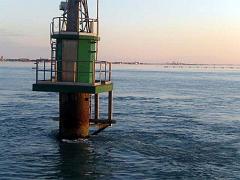
07/03/09 17.16
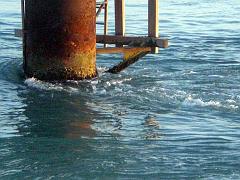
07/03/09 17.18
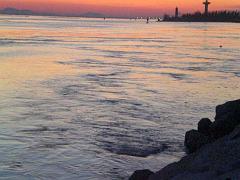
07/03/09 17.55 Foto Tello De Marco
|
Flood tide in the Canale dei Petroli
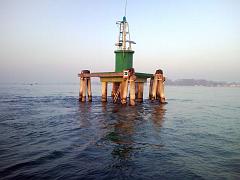
07/04/09
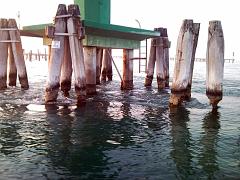
07/04/09
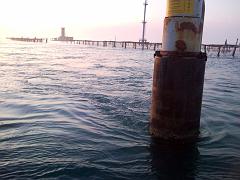
07/04/09 Foto U.Sartori
|
Near the end of 16th Century, fine tuning the absorbing capacity of these new Lagoon areas South of St. Leonard through artificial canals called "Garzoni", it was possible to balance the tide streams generated by the two Port mouths in proximity of the political and commercial centre of the Most Serene Republic.
Conditions were created where each stream would counterbalance the other's velocity in a zone located half the way respect the isle of Lido. This area would not only moderate water speed in the whole Lagoon, but also work as a dynamic mud storage, and was called "Zona di Partiacque" (watershed area).
To obtain this area of staunch water right behind the Historical Centre of Venice were sacrificed also breeding grounds like those survived of St. Ilario Abbey and Historical Heritages like St. Marco in Boccalama.
Leaving on the contrary wild the stream from St. Nicolò allowing it to ride till St. Leonardo and then back on Venice with such a run-up, would have been Venice itself to be eroded in a short while.
Riseing instead the underflow through the Port Mouth of Malamocco, that stream was empowered enough to push it to an ideal arc between Malamocco (town) and Fusina, where the Moranzano Canal could feed under human control the watershed area with new sediments to be slowly released to the Sea.
This admirable work of harmonization with Nature was so well devised and realized to resist along centuries, preserving the gem it was aimed to protect.
The ideological decay in safeguarding the Lagoon of Venice begins probably with the illuministic arrogance, pretending to reduce the Lagoon to a totally artificial event, starting a oppositive instead of the ancient juxtapositive procedure between Human Works and Nature.
To the illuministic age belongs infact the "linea di conterminazione" as is the estabilishment of an artificial Lagoon coast line, applying fixed and improper Cartesian parameters to a reality itself fickle, accordingly with the fractal logic of Nature.
Nevertheless, the strong Tradition preserved in the "Magistrati alle Acque" and the deep feeling tieing Venetians to the Water, succeeded in influencing the Good Common Sense of the Austro-Hungarian to preserve the Lagoon balance also across that Domination.
|
|
Not even the much less common sensed occupation of the Savoias (Kings of Italy) was able, in its beginnings, to lower the ancient Authority in safeguarding the Lagoon, mantained by the "Savi alle Aque" on their Lagoon. The "Statuto Albertino", indeed, started to oust that power, saddleing important offices to elements completely inadequate for cultural belongings and local knowledge (Statuto Albertino was a bureaucratic setup of the Italian Kingdom prescribeing that officialdoms from the South should perform their duty in the North of Italy and viceversa).
It was with the first partitioning of the Monarchy toward democracy, that is the call to Govern of Mr. Benito Mussolini and his "bivouac of squadrists", when the hydrostatic balance tenure of the Lagoon started to be seriously menaced.
Huge fill-ins in Marghera and St. Giuliano, doubleing, with the Ponte Littorio, of the already inopportune trans-lagoon bridge wanted for army reasons by the Austro-Hungaric Empire, excavation and fill in of various rios inside the Historical Centre, were the first symptoms of the actual ruin brought by the transforming of that dictatorial democracy in this sectarian one which has distinguished Italy along the last 70 years.
I think it is clear enough from the context that with the word "democracy" I do not refere to the bunch of fabrications and forgeries we have been stuffed with by the parties system demagogues, but, along with the ancient and etymological meaning, to the social structure of the barbarian horde, where the more brutal in crime rules.
The "power to the rabble" (this is the meaning of "democracy" for the ancient Greeks and for the Fathers of Political Science), just installed in its worst shape of nepotistic electioneering, started nullifying the sacrifice of St. Ilario and St. Marco in Boccalama.
The salty marshes used to empower the stream of Malamocco without pointing it directly against the Historical Centre were filled in with the first Huge Act of Vandalism, known as "casse di colmata".
Close to them a new canal is excaved, called "Canale dei Petroli", whose size is incompatible with the balance of the dynamics of the Lagoon, realizeing the Second Huge Act of Vandalism against the multi-secular hydrostatic balance of the Lagoon of Venice.
The capacity, velocity and direction of the stream from Malamocco were dramatically modified, not in function of a better hydrostatic balance, but just complying with commercial interests as much wreched as short-sighted, in total disregard of the elemental principles which safeguarded the Common Wealth and the Sacred Water Walls of Motherland.
|
Flow tide in the internal rios
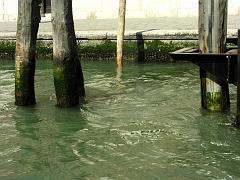
Canale di Canaregio 09/04/09
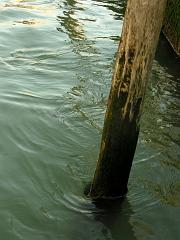
Canale di Canaregio 09/04/09
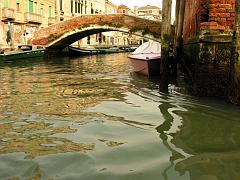 Rio della Misericordia - Rio dei Servi 26/02/09
|
Flow tide in the internal rios
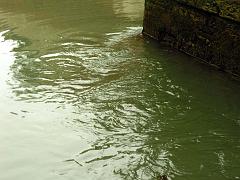
rio di San-Marcuola - rio dei Servi 08/03/09
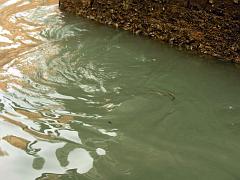
rio di San Marcuola - rio dei Servi 26/02/09
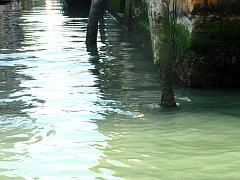
rio di Noale - rio Trapolin 09/04/09
|
The consequences of this double, huge hydraulic nonsense were both immediate and long term. The impact of the empowered direct wave from Malamocco eroded and erodes the salty marshes South and West od St. Leonard.
The inhabited islands Torson di Sotto and Rivola Vecchia are erased to the bone in the turn of five years, notwithstanding the slapstick comedy of defending them with palisades.
Slamming against the barrier of the casse di colmata, and pushed fiercely by the enormous mass of water convoyed by the fool Canale dei Petroli, the tide from Malamocco unbalance the resistence of St. Nicolò's wave on top of the watershed line, bending it more and more towards Marghera and St. Giuliano and in a stream of waters converging in whirl.
Less than twenty years are sufficient to bring the tide from Malamocco along the Lagoon inner coast up to Tessera, riseing more and more its velocity and capacity of underflow and erosion.
Twenty years more and comes into action the Third Huge Act of Vandalism against Lagoon balance, better known as "MOSE project", which modifyes the stream since the Port Mouth of St. Nicolò, diverting and narrowing the nozzles of the Lagoon.
Today, 2009, the watershed area is wracked. The tide entering from Malamocco compresses that entering from St. Nicolò pumping it across the smalll North-South rios of the Historical Centre, which were born and structured to support just light movements of flow and flood.
Instead of balanceing the opposite wave, the tide from Malamocco literally bend in whirl that from St. Nicolò. Level with Sacca Fisola, the two streams yet proceed side by side in direction of the North Lagoon.
Their combined impact bends and convoy, by the Canale di Cannaregio, also the stream entering from St. Nicolò through the North-South rios and along the Murano and Fondamente Nove canals.
The hydraulic system has been changed from lagoon to that of a port of strong undertow. In the pictures we can see the speed of the stream in the rios of the Historical Centre.
|
|
Watching live, one gets the sensation of looking at a mill-race speed. The situation of undertow must be indeed regarded as much more disruptive than the river-like one, being the undertow a continuous alternate movement, similar to that of a saw.
Like a saw the water produce different effects while going and when comeing. The flood tide opens the way and move the debris, so that the flowing tida may thrust its teeth more deeply in what stands in its way.
|
|
|
|
|
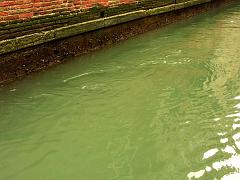
rio di San Felice 08/03/09
|
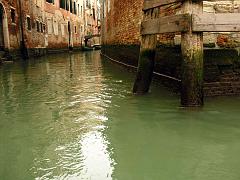
rio dei SS Apostoli - rio Widmann 08/03/09
|
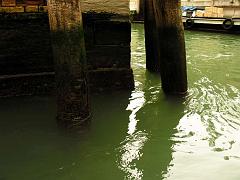
rio dei SS Apostoli - rio Widmann 08/03/09
|
The effects on the buildings' basis
In the following photos we can see the effect of the hydraulic saw on the water foundation of the buildings. These are but a few of the innumerable ruptures that can be observed everywhere along the rios of Venice.
Remark how erosion is everywhere lengthwise. In particular the first two pictures, which refer to the flop down of the Fondamenta in front of Diego Valeri School, show how erosion is deep even under the low tide level the photo has been shooted in.
The pick work of the more and more violent waves from the boats, now is joined by the steady shovel work of the more and more whirling tide stream.
There is no more hope for Venice and her Lagoon if we do not run back to the wisdom and the Virtue of the Fathers.
|
THE POTHOLES AND THE LONG AND THIN EROSION
|
|---|
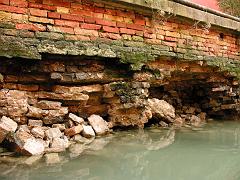
Scuola Diego Valeri 26/02/09
|
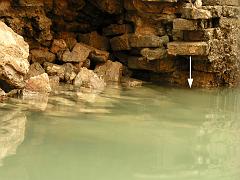
Scuola Diego Valeri 26/02/09
|
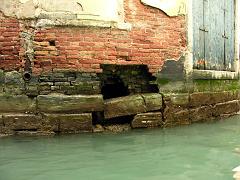
rio della Fava - rio dei Tedeschi 28/02/09
|
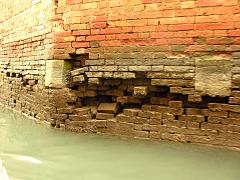
rio delle Beccarie 28/02/09
|
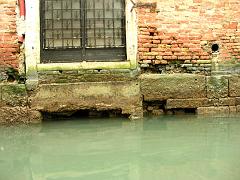
rio delle Beccarie 28/02/09
|
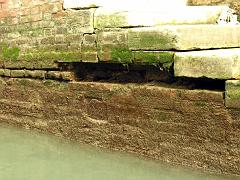
rio de le Muneghete 28/02/09
|
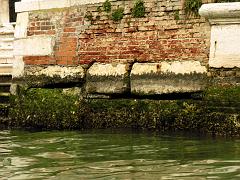
rio della Misericordia - rio di Noale 08/03/09
|
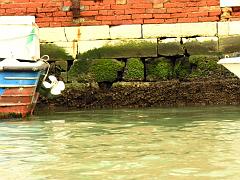
rio di Santa Caterina 08/03/09
|
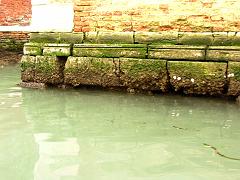
rio di Santa Caterina - rio Racheta 08/03/09
|
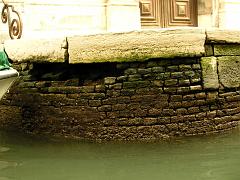
rio di ca Widmann 08/03/09
|
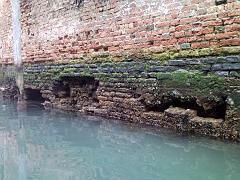
rio delle Vergini 07/04/09
|
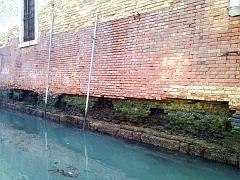
rio delle Vergini 07/04/09
|
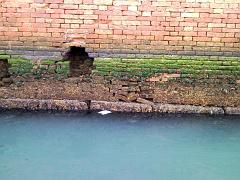
rio delle Vergini 07/04/09
|
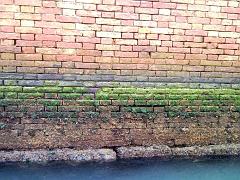
rio delle Vergini 07/04/09
|
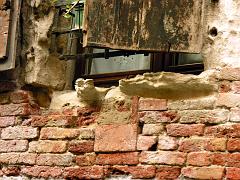
solfatazione 2009 28/02/09
|
If Water has started its work of destruction from the foundations, the Fire of Sulphur melted in the Air busily collaborate to bring the Work of Man to the mud of the beasts.
Do people want to be "mass"? Mass means "mound of clay", mud pie indeed.
Venice does not deny her magic. She mirrored the Venetian People in its greatness and now She admonish them of their misery, and abandon them.
|
This work is dedicated to my father Sergio, whose love for the Lagoon has formed my sensibility since childhood.
Thanks to Stefano Alessandri for sharing with me his experience about the inner coast of the South Lagoon.
Thanks also to the Authors of "Morfologia Storica della Laguna di Venezia", Arsenale ed., Venezia 1988, for the great work with the ancient maps and further historical data.
I could complete the Historical Centre stream model thanks to the information by the Canottieri Giudecca about main stream directions along the Lido. Information that I have later personally verified.
|
TOP
Warning: include(hyperlangINT_en.php): failed to open stream: No such file or directory in /var/www/vhosts/venicexplorer.net/httpdocs/ombranet/general_header.php on line 3
Warning: include(): Failed opening 'hyperlangINT_en.php' for inclusion (include_path='./langs') in /var/www/vhosts/venicexplorer.net/httpdocs/ombranet/general_header.php on line 3
Warning: include(hyperlang_en.php): failed to open stream: No such file or directory in /var/www/vhosts/venicexplorer.net/httpdocs/ombranet/general_header.php on line 4
Warning: include(): Failed opening 'hyperlang_en.php' for inclusion (include_path='./langs') in /var/www/vhosts/venicexplorer.net/httpdocs/ombranet/general_header.php on line 4
|